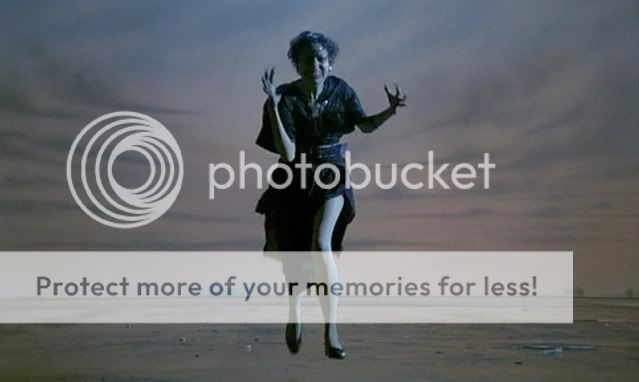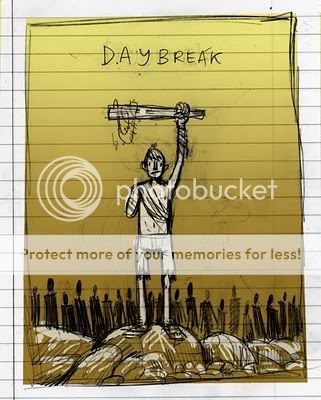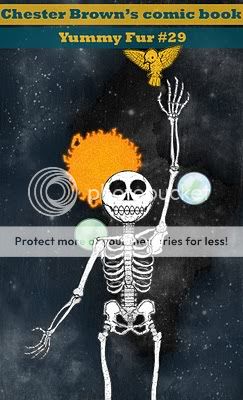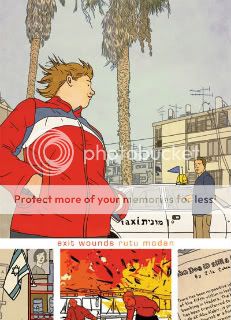Archive for August 9, 2010
Comics Time: Cyclone Bill & the Tall Tales
August 9, 2010Cyclone Bill and the Tall Tales
Dan Dougherty, writer/artist
Moonstone, 2006
232 pages
$16.95
Fictional comic stories about music are often not just bad, but embarrassingly, infuriatingly bad. I’m not sure why this is, to be honest. I think the answer may be found in noting the tendency of stories about obscure/failed/garage/shitty bands/music (e.g. Jaime Hernandez, Gipi, Bryan Lee O’Malley, Makoto Yukimura) to be much much better than stories about famous/successful/stylish/supercool bands/music (you can probably rattle off the names of several such failed series from the past five years, easy).
First, the roundabout explanation. When you’re tackling music just as a thing people do out of compulsion or enjoyment, independent of external payoff, that’s universal. But when you’re approaching music as something that makes its practitioners that much more awesome than everyone else, you invite your readers to compare your depiction of that awesomeness to what they, personally, find awesome about the music they find awesome. And when that comparison clashes–as it often does, because rock-star hero worship is an enormously personal thing, millions of idiosyncratically intimate relationship established with fantasy figures–it’s throw-the-book-out-the-fucking-window time. The book ends up feeling…like a costume, a disguise, not like an outfit. (Weirdly, I don’t think this rule applies as neatly to movies as it does to comics. Maybe it’s because movies have an inherent glamour to them that comics don’t, so they can address the glamour more naturally, I don’t know. I really like Eddie & the Cruisers, is what I’m saying.)
But a more direct explanation would simply be “show, don’t tell.” In my experience, comics-about-music that pivot off the involved parties’ coolness tend to absolutely bury the reader in LOOK HOW COOL THIS STUFF IS!!!!isms, which is death for coolness in fiction as it is in real life. (Seriously, people who think Geoff Johns lays on the Hal Jordan hero worship too thick in Green Lantern need to get back to me after reading any recent series that invokes the British rock tradition in any way.) You don’t see the flopsweat when reading about the misadventures of Sex Bob-omb or La Llorona–they just do what they do, and that’s why it works.
Cyclone Bill & the Tall Tales falls somewhere in the middle, in large part because of what an odd, odd book it is. I stumbled across one of the single issues while working at Wizard, in a pile of the “well, somebody out there’s readin’ it, I guess”-type comics that tended to accrue here and there. It’s done in a painted, grey-tone black-and-white style that really does have more in common with alternative comics than “indy comics” of the sort you might expect from a publisher whose bread and butter is the randomest bunch of licensed properties you can imagine. (Kolchak the Night Stalker!) Writer/artist Dougherty’s work here is undoubtedly the work of a young cartoonist–it’s stiff at times, unequal to the tasks he sets for himself (like the first-person POV videotape mockumentary storytelling device that recurs throughout) at others–but there’s also much to admire and enjoy, from the attractive character designs to the stark, angular, expressionist overall look.
Moreover, the story boasts gratuitously weird elements galore. The nominal protagonist, documentarian Margarita Bloom, spending what seems like half the book asleep on the couch. Cyclone Bill, the titular guitar god whose untimely onstage murder (yep, it’s that kinda deal) is the center of the story, is a classically trained prodigy from Poland who toured the great halls of Europe before disappearing to become a Catholic priest or something, then reemerging as the second coming of Jimi Hendrix after plucking an undistinguished American bar band out of obscurity and joining them as their lead guitarist. Dougherty even casts himself and his real-world bandmates as main characters–Bill’s band, the Tall Tales. It’s all really quite singular, especially because Dougherty has left this sort of comic behind–he now does a humor strip about a coffee-shop clerk with a web page done in Comic Sans. Then as now, my first thought upon looking at this book is “Where the heck did this thing come from?”
This is not to say that the story doesn’t traffic heavily in traditional signifiers of cool, because it does. It’s the sort of comic in which a recreation of the famous photo in which Johnny Cash flips off the camera is used as a major plot point, if that helps. But in the main, it’s trafficking in such a hoary, out-of-fashion brand of rock and roll coolness that it’s practically gone all the way around to uncool again. Robert Johnson at the crossroads, Elvis Presley still haunting the highways of the Great American Nowhere, sinister significant others in the Yoko Ono role, a slogan-spouting punk as the antagonist, deals with the Devil in which souls are sold for rock ‘n’ roll, a celestial gathering of dead rock stars…this is your father’s musical mythmaking. Yeah, I cringed a little when Freddie Mercury, Kurt Cobain, John Lennon, Jim Morrison, and Elvis Presely teamed up to kick Satan’s ass around Graceland, but not as much as I’d have done had Jarvis Cocker been involved, you know? It’s far enough away from where I am not to clash so violently.
No, it’s not the Velvet Goldmine of comics I’ve long hoped for–a story that’s both reality-warpingly personal in its approach to the musical icons it’s dealing with, but also accessible enough to people who aren’t the creator to reveal something about the music and musicians involved, and entertaining enough for that not even to matter. But it is Doughterty laying it all on the line in terms of his love for a certain rock and roll tradition, fashion be damned, and that’s admirable in its own way. It’s a fictional comic about music that didn’t make me want to light it or myself on fire by the end, which is an achievement in and of itself.
“C’mon Catfish, c’mon play a little hard, uh!”
August 6, 2010In college, some friends introduced me, under circumstances you can probably imagine, to the concept of “the Cosmic Groove”–the funk into which all bands seek to tap, but which aside from a few fleeing moments remains elusive. It wasn’t until I heard Phelps “Catfish” Collins’s guitar solo on “Very Yes” with Bootsy’s Rubber Band live in Lousiville 1978 that I understood what they meant. That guitar is like the Ghostbusters crossing the streams, and when the horns come back in, that’s the dimensional crossrip. This is the sound of the cosmic groove–it’s like My Bloody Valentine’s “Soon” in that I’ve wanted so badly to find another song that does what this does as well as it does it but have never found it and probably never will. Rest in peace, Catfish.
Comics Time: The Witness
August 6, 2010The Witness
Hob, writer/artist
self-published, 2008
24 pages
$3
Comics about death, even good comics about death, are a dime a dozen.. Comics about death where the character that dies is biologically incapable of understanding what has happened to it? And in which the entire world dies, completely and irrevocably, taking all hope of future life with it? Rarer, and thank goodness, because I don’t know how many comics like this one I could take without cracking. This is not to say that the artist otherwise known as Eli Bishop’s “ghost story” about a dinosaur whose spirit lingers on Earth, occasionally interacting with its inhabitants (both alive and dead) until the solar system’s destruction billions of years from now by the expanding sun, is morbid or grim beyond the needs of the subject. Something about his airy, elegant line–able to convey the weightlessness of the dino-ghost and to accrue background detail without bogging the image down–prevents The Witness from ever feeling dreary or didactic. But that’s just it: This casual acceptance of the death of all things, a post-life eternity that just spirals on and on and on and on and on and on without ending, ended up being much more chilling to me than most stories about shuffling off this mortal coil. I’ve thought about my eventual expiration enough that doing so is like meeting a familiar friend. But death without the possibility of thought, by you, by anyone or anything else? That’s a stranger at the door and I’m afraid to let him in.
Carnival of souls
August 5, 2010* Dunno how the heck I missed this, but Mike Mignola will be drawing Hellboy again following the conclusion of the current six-part-total arc with Duncan Fegredo.
* Ben Jones has a blog at PictureBox’s site now? When did this happen? (Via Flog.)
* Good golly Miss Molly, look at this drawing of Galactus by James Stokoe. Click here to make it bigger than your brain can handle.

* Gabrielle Bell is now on Jordan Crane’s webcomics site What Things Do, with maybe the first of her strips I feel like I’ve “gotten.”
* Real Life Horror: Here’s a fascinating, if scantly supported, article on the prevalence of serial killers in Africa, enabled by the combination of weak law enforcement and ritual traditions that countenance violence. (Via CRwM.)
Music Time: Wild Beasts – Two Dancers
August 5, 2010Wild Beasts
Two Dancers
Domino, September 2009
Co-lead singers Hayden Thorpe and Tom Fleming represent the meticulously struck balance of Wild Beasts’ second album of sumptuous, occasionally shocking art-rock Two Dancers as well as anything else. Like Bryan Ferry subjected to some sort of Silver Age DC Comics bifurcation beam, Thorpe sings in a foppish falsetto, Fleming in a rich mahogany baritone. Each vocal approach enhances different aspects of the band’s music: Thorpe’s swoops and screeches twirl effortlessly atop and around the keening guitar of Ben Little, while Fleming’s warmth and fullness echoes the rock-solid foundation laid down by his basslines and Chris Talbot’s surefooted drumming.
Yet at the same time, each undercuts and complicates the lyrics they sing, lyrics that treat male desire and anger with often alarming openness. Thorpe can deliver kiss-offs to a former lover like “This is a booty call–my boot up your asshole” (“The Fun Powder Plot”) or proclaim his penchant for hooliganism by announcing “We’re just brutes, looking for shops to loot” (“Hooting & Howling”) and get away with it, his dandyish, defiantly artificial voice stripping the words of tough-guy posturing and exposing the awkwardly animalistic sentiments beneath. For his part, Fleming can flat-out sing about his id, as he does in “All the King’s Men”–“Baby, turns out I’m evil / In all my dreams, girls who’ll clothe me, girls who’ll feed me, girls who want me, girls who need me”–but the Guinness-like depth and complexity of his tone conveys far more self-awareness and self-effacement than self-congratulation. The lyrics’ repeated references to the body parts involved in sundry acts of rage and lust and gluttony further emphasize the degree to which these men, for all their erudition, are at the mercy of meatspace. I count fully 46 mentions of everything from bones and teeth to hearts and lungs to ankles and assholes in the lyric sheet; tellingly, the eyes, the window to the soul, are only mentioned once.
Given this, it’s no surprise that the group assigns the album’s sexiest song–the churning “When I’m Sleepy…,” its lyrics consisting solely of the phrase “When I’m sleepy, needing supper, you’re the lips for me to pucker”–to the more feminine vocalist, while the baritone is responsible for the harrowing semi-title track “Two Dancers (i)” and its seemingly and sympathetically feminine perspective on sexual assault and the death of and abandonment by children. Simply the phrases selected to convey these ideas–“His hairy hands, his falling fists, his dancing cock down by his knees”; “Our son was dying and we could hardly eat”–form a devastating j’accuse when issued from the bass clef.
The music seems similarly obsessed with the possibilities of duality represented by both singers and album title. The title track is split in two, for one thing, with “Two Dancers (ii)” representing a quieter, colder response to the fiery demands of its immediate predecessor; the pair is itself prefigured by the introduction of its central melodic hook at the very end of “Hooting & Howling” several songs earlier. The album features two short interlude-type songs: The first is the aforementioned sizzler “When I’m Sleepy…”, while the second, the far quieter “Underbelly,” is as much about lifelong consequences for the seven deadlies as the earlier song is about their immediate gratification. But my favorite pairing is the opening track, “The Fun Powder Plot,” with the late-album centerpiece “This Is Our Lot.” To take things back to the Silver Age, they’re each the Bizarro version of the other. With the same gently twirling mechanical beat and even the same key, “This Is Our Lot” inverts the earlier song, allowing the bass to provide the melody and the guitar to provide the rhythm–a switch paralleled by Thorpe, who here sings toward the bottom of his register. The overall shift is one from hysterical outrage to wry resignation, “The mock” and “the shock” of “The Fun Powder Plot” replaced by the shrugged-shoulder admission “This is our lot: We hold each other up heavy with hops.”
The end result? Masculinity without machismo. Sexuality without sexism. Elegance without arrogance. Wild Beasts set a very tricky lyrical and stylistic course for themselves here, but their rare combination of ambition and sophistication sees them arrive not just safely but spectacularly.
A request
August 4, 2010I would like to move my blog to a new, dedicated site. I need someone to help me do this–namely to design the new site and port my Movable Type archives into it. I have some other more ambitious wishlist items too, but those are the main things. I will pay this hypothetical person for doing this. Are you this person? Please email me (the address is in the left-hand sidebar of this blog) and let me know.
Carnival of souls
August 4, 2010* Your quote of the day comes from Tom Spurgeon:
Mostly, though, I’m kind of baffled why retailers meet anything I write that’s critical of any facet of the Direct Market with such forceful, blanket and frankly not always very convincing rebuttals….what’s up with the defensive crouch? How on earth is a critical article tantamount to taking a position of “all doom and gloom?” Do you have a self-critical apparatus? Is ComicsPRO simply a booster organization that does things like impugn others’ motives and make empty proclamations that things are “rock solid”? If asked, could you name five specific areas at which the Direct Market should improve, things at which you and your fellow retailers have outright failed, not somebody else? I could do that for this site specifically and comics journalism generally, and have talked about those factors here at the site on multiple occasions. Why can’t you guys? It’s one thing that outright confuses me about comics 16 years in, retail and elsewhere. What is it about comics people that we’re afraid to release real sales or (when it’s appropriate) income figures, where publishing moves that seem to under-perform disastrously by the estimates we do have are met with a “that’s right what we expected/you don’t know anything about the business” harangues, where it’s the comics event itself that conspires to keep the journalists from covering it with greater vigor? Why can’t we be self-critical?
Read the whole thing, including the jaw-dropping letter to which he’s responding.
* Mike Baehr notes in the comments downblog and on the Fantagraphics blog that Fanta/Eros isn’t republishing Hans Rickheit’s Chloe, just distributing it to the Direct Market for, amazingly, the first time. Really can’t say enough good things about that book, though I’ve got a funny feeling I’ll be trying to over the next week or so.
* Jeet Heer’s piece on Harvey Pekar for Comics Comics contains a pretty egregious misreading of the Lee/Kirby working relationship, of all things, but is well worth your time anyway for its emphasis on the salutary impact Pekar had on Crumb rather than the other way around, and how Pekar’s preference for realistic writing may have skewed his taste in artists in an unfortunate way.
* Somehow the RSS feed for Sammy Harkham’s Family store blog disappeared from my Google Reader or something, but thanks to Spurge I’m tuned back in in time to catch Sammy’s salute to Richard McGuire, perhaps the only person of whom it can be said that they created one of the greatest comics and greatest basslines of all time.
* Harkham also posted some more pics of the ice cream truck Ben Jones designed for Adult Swim’s San Diego presence. Would you let your kids get a froggy pop from this truck?
* John Lingan’s piece on Christian Nyby/Howard Hawks’s The Thing from Another World and John Carpenter’s remake The Thing is odd in that it posits a world in which the former has the better critical reputation, a world I’m pretty sure the rest of us don’t live in, but hey, I’m always up to read about The Thing. Nice analysis of the purpose of the spectacular gore, for example.
* Frank Santoro sez don’t forget that your comics page needs a center. This came up in his Inkstuds roundtable from the other day as well. I’m still processing it.
* Filing this away for future reference: Chris Mautner reviews Scott Pilgrim vs. the World.
* Speaking of Scott Pilgrim, here’s a fun, frivolous report on an in-store appearance by Edgar Wright, Michael Cera, Anna Kendrick, and Jason Schwartzman by my chum Jason Adams.
* And speaking of Jason, he says that this is what Lamberto Bava’s Demons 2 looks like, which probably means I need to see Lamberto Bava’s Demons 2.
* Clive Barker Halloween costumes! Yep, that’s about right. How I love this raspy-voiced loon. (Via Monster Brains.)
* Real Life Horror: The Journal of American Medicine on the damage done by CIA doctors and psychiatrists who tortured people for the Bush Administration.
* So epic. When my teenage self first saw this image, a rip in the spacetime continuum opened up and John Williams’s “Duel of the Fates” started playing.
Comics Time: Prison Pit: Book 2
August 4, 2010Prison Pit: Book 2
Johnny Ryan, writer/artist
Fantagraphics, July 2010
116 pages
$12.99
“OPERATION: RAPE LADYDACTYL. BEGIN.”
It wasn’t until I read those words on the screen of a computer operated by a robotic antagonist of Prison Pit‘s main character Cannibal Fuckface that I realized just how far Johnny Ryan was going to go with this series. Obviously it was already beyond violent; obviously it was already beyond sexually vulgar as well, what with Volume One’s maggot-fellatio fade-out. Obviously Volume Two was already filled to bursting with literally nauseating body-horror transformations and mutilations brought to life (and death) by Ryan’s never better, never nastier pen art. But an extended sequence in which our anti-hero is forced against his will to hunt down, attack, maim, and graphically rape-murder a creature that’s distinctly female even for all its monstrousness, one that screams in agony…for the first time I realized that Prison Pit isn’t a fusion-comics exploration of awesomeness in all its forms, but a horror-comics exploration of awfulness–of violence that maims and kills not just body but soul. Ryan is willing, even this early in a series I imagine will be able to last as long as he wants it to, to completely invert his instantly-iconic warrior, to make the audience root against him desperately, to feel dick-shriveling revulsion at his violence and pity for his victim. “That fucking sucked,” CF says when it’s all over. Understatement of the year. This book is a masterpiece of awfulness.
Carnival of souls
August 3, 2010* Big new books from Ben Katchor and Daniel Clowes on the way from Pantheon next spring. The Cardboard Valise is Katchor’s first book in ten years plus, while Clowes’s Mister Wonderful will apparently include 40 new pages.
* Whoa, Fantagraphics is rereleasing Hans Rickheit’s Xeric-winning graphic novel Chloe through its Eros imprint? I wish it were being done by Fanta proper–the fact that it isn’t explains why I didn’t know about it until today–but even still, run, don’t walk, to get that book. Rickheit’s a major talent and that book is something erotic and special. It’s like a dirty secret.
* Spectacularly talented alternative cartoonists: They’re just like us! Kevin Huizenga rents random popular comedies and genre movies from the library!
* I’m glad this worked out for all concerned, but still, threatening a licensed publisher of a franchise over infringing the copyright of your fan-film based on that franchise? How would that work, exactly?
* Alyssa Rosenberg considers A Song of Ice and Fire, Harry Potter, The Lord of the Rings, world-building, and emotional wiggle room.
* These Brian Ralph sketches sure look like Daybreak collected-edition cover mock-ups to me…
* The Rocky Horror Picture Show on Blu-Ray. Don’t know why that never occurred to me before.
* Nor had it ever occurred to me to look for the Predator soundtrack album, which apparently is only now coming into existence.
* Tom Ewing is right: that new Arcade Fire song is not hot. Personally, I tuned out when they rhymed “sprawl” with “shopping malls,” like a Bad Religion album cut. I wouldn’t go quite as far as Mike Barthel because I think it’s perfectly legitimate to remain aghast at a lot of what goes on in suburbia even as an adult; I just think it’s bloated, boring music and trite lyrics delivered with irritating vocals, which is what I’ve always thought of the Arcade Fire.
* Real Life Horror: When I, a proven fool or worse on such matters, talk about politics on this blog these days, it’s usually in the horror-tinged context of torture or the action/sci-fi framework of a militarized Republican party. But of course these two phenomena are not unrelated. And now we can perhaps add a third category, as articulated by Jim Henley: the degree to which the ugly bigoted sentiments of a swathe of the American right are now being made manifest as actual discriminatory policy, from already nationwide attempts to thwart the construction of mosques anywhere for any reason, to attempts to revise or reinterpret (or repeal?) the 14th Amendment so as to deny birthright citizenship to so-called “anchor babies” on the basis of no one knows what exactly. To a degree, we’re all the blind men feeling the elephant when it comes to the darker forces at work in American political life today. Well, here we have a movement that supports the government’s ability to imprison and torture its perceived enemies at will; that makes a habit of arming itself and discusses this as a potential way to redress its grievances with its political and governmental opposition; and which seeks to abrogate basic constitutional rights for minority ethnic and religious groups deemed insufficiently American. What does that elephant look like to you?
Music Time: Spoon – “Who Makes Your Money”
August 3, 2010Spoon
“Who Makes Your Money”
from Transference
Merge, January 2010
Restraint can be so sexy! Listen to the minimalist groove of this song: It’s mostly a tight pencil sketch of a drumbeat and a three-note keyboard hook that sounds like fingertips just barely grazing the keys. The bass comes in not much more often than every other measure, just enough to keep the low end a presence in your mind. There’s a rhythm-guitar…undercurrent, is the best word for it. Every once in a while there’s a little textural sizzle that fades in and out. Even the vocals are deployed with the minimal sufficient force: The titular refrain is so underpronounced that I spent my first listen to the song thinking it was called “Who Makes You Mine.” And perhaps with that in mind I thought this was a song about dark, possessive sexuality–a misconception that did not change one iota when I found out the real title, by the way. It was only when I made a point of seeking out the lyrics that I discovered it’s actually a song about being a slave to the wage, not a slave to love. But with an arrangement this exquisitely perched on the precipice between sensuous and ominous, it works either way.
Carnival of souls
August 2, 2010* I interviewed Grant Morrison and Adam Egypt Mortimer about their upcoming film Sinatoro for Comic Book Resources. Because it’s so early in the game they are in large part limited to enthusiasm and hyperbole, but they’re pretty self-aware about that. I liked this bit:
We wanted to do something that took the language of movies and brings it into the 21st century. One of the things I was saying over the weekend was this idea that most of us have been playing video games and grew up watching MTV and music videos. The art that we’ve absorbed has changed. The way we look at things and the way we tell stories is a little bit different than how it used to be. I like the idea of introducing that back into the basic Hollywood narrative. Taking some of that, and all the building blocks we’re familiar with – the boy-meets-girl, the revenge story, the thriller, the murder mystery, the crime story – and combine all that together. It”s a little like what I did with Batman and Superman: take all the things we love about cinema and then put them together again in a slightly new way which still fulfills all the [original] functions. It still makes you laugh and cry and sing and dance.
* Clive Barker says Volume III of his Abarat young-adult fantasy series will come out in September 2011. Given that what would have been the ending in most YA fantasy series took place at the end of Volume 2, I suppose it’s no shock it’s taking this long to ramp up to the next installment.
* Since I am increasingly pessimistic about the economy in general and the long-term structural changes being made that will adversely effect the creation of art in particular, I’m always game for discussions Tom Spurgeon’s thoughts on the future of comics retail in a piece on five comics news stories to watch:
It’s take your pick of portents: the absence of a vital retailer selling new comics at Comic-Con the way Comic Relief used to underlines the notion that owner of the majority of comics’ best shops are getting older, there’s never a guarantee that these businesses change hands without causing major differences in what they’re able to do, and I’m not sure there are enough up and coming retailers to play the same role as the generation of retailers now in that 55 and over club. Price increases, continued horrific scheduling strategies, a ridiculous and inflexible start-up model, over-publishing and the slight discombobulation that is likely to arrive with an upswing in attention to digital comics strategies are making things more difficult for the system just at the time when everything should be done to make things easier. As second downswing in the economy will likely drive lot of folks to reconsider what they do, and comics seems less likely to escape a second generally fallow period coming so quickly on the heels of the first.
* I am enjoying Robin McConnell’s Inkstuds roundtable on “fusion comics,” aka the New Action plus some other mixed-genre/style stuff, with Frank Santoro, Brandon Graham, and Michael DeForge as we speak. Here are Frank’s notes for the interview. Obviously a lot of this material excites me as well, and I love all these artists bringing non-traditional influences to the table. It makes for exciting art, and exciting discussions between artists. As for criticism…Honestly? I do worry a bit, from a look around the blogosphere on any given day, that rise of fusion/New Action gives people the critical cover they’ve long secretly craved to talk only about genre, to the exclusion of non-genre work. (I oughta know!) Oh, I dunno, I’m a scold these days. Maybe it’s just that I’ve always proceeded from the notion that this stuff is legit to talk about, and so it doesn’t fire me up, like, eight years into talking about comics professionally and semiprofessionally. I’ve got my own issues, like.
* CRwM waxes eloquent on John McTiernan’s Predator and Die Hard, two films that undercut the Action Hero, examining the varying degrees to which they do so. Check the comments for TroyZ’s take on the matter as well.
* The Ten Video Games Roger Ebert Should Play. I’ve never been heavily invested in what Ebert thinks and this has not changed with his recent renaissance, but a) It’d be interesting if the collective Green Lantern power of the Internet wills him into liking video games after a prolonged period of philistinism, and b) this list doubles well as a Ten Video Games Sean T. Collins Should Play list.
* I’d forgotten how good the cover for Chester Brown’s Yummy Fur #29 was; Ruaraidh Bruce reminds us with a cover version at Covered.
* I love Rickey Purdin “What I Got at [Comic Convention X]” posts, because Rickey Purdin loves getting comics.
* I briefly want to draw your attention to a couple of other Internet ventures for which I am responsible: Fuck Yeah, T-Shirts, consisting of cool pictures of people wearing t-shirts;
* and Bowie Loves Beyonce, consisting of cool pictures of David Bowie and Beyonce.
* It’s been a while, for medical reasons, but I would like Serge Gainsbourg’s “Cannabis” (via Nate Patrin) to provide the soundtrack for all my future usages of the titular substance. I suspect it would be impossible not to feel like a cool dude with all the right moves under such circumstances.
* An LCD Soundsystem/Hot Chip/Sleigh Bells tour? Oh, indeed.
Comics Time: Exit Wounds
August 2, 2010Exit Wounds
Rutu Modan, writer/artist
Drawn & Quarterly, 2007
168 pages
$16.95
What a lovely-looking book Exit Wounds is. Rutu Modan’s skillful take on the Clear Line style elicits strong “performances” from her characters, creates an inviting depth of field, and holds her frequently sumptuous colors quite well. Her staging is rarely as dynamic as that cover image, but when it is, hoo boy, fabulous stuff. Overall I feel like she’s doing with the Clear Line what Emmanuel Guibert tried but failed to do in an inkier style: Take real life and gradually subtract detail until what remains is paradoxically even livelier.
The story? Eh. It’s your basic alternative-comics “young person’s personal epiphany enabled by unexpected, brief, intense, difficult relationship with other young person” story, a template established by the likes of I Never Liked You, Black Hole, and Ghost World, gone supernova with Blankets, and since utilized to varying degrees of success by Adrian Tomine, Danica Novgorodoff, Blaise Larmee, Paul Hornschemeier, Dash Shaw, Hope Larson, Bryan Lee O’Malley, the Tamaki sisters cousins, Natsume Ono, Inio Asano, and so on and so forth. This particular variation is uninspired and, literally, unsurprising. When their personalities clashed; when they fell into an uneasy rapport that slowly grew into an easy one; when they argued and made up; when they staved off emotional disaster by having ill-advised sex; when they stormily split up; when they capped off the book with a highly symbolic interpersonal act–each of these elicited a “yep, that’s pretty much what I expected” from me.
The affair is sprinkled with light commentary about Israel’s social, economic, ethnic, and denominational stratification. It’s subtle, thoughtful stuff, focusing on the way that both the state’s inherent construction and its predicament vis a vis its neighbors and occupation-ees constantly juts into people’s personal lives in mostly quiet, mostly unpleasant ways. That and the sumptuous art is probably what got the book over with so many readers and critics. But to me, it’s a little like getting a molten chocolate cake with no molten chocolate inside. It’s not quite a hollow experience, like one of those chocolate Easter bunnies where it’s just a thin layer of yummy and then a lot of air–the cake is substantial and sweet. But without the molten chocolate that a less predictable, more alive story would provide, you still feel like something’s missing.
Music Time: 80 Great Tracks from the 1990s That Aren’t on Pitchfork’s Top 200 Tracks of the 1990s List
August 1, 2010BACKDATED FOR EASE OF BROWSING
I enjoyed Pitchfork’s list of the Top 200 Tracks of the 1990s. The decision to limit the list to one song per artist opened things up to tons of songs, probably even whole genres, that would have been excluded if folks like Bjork and Beck and Radiohead each had five songs a piece or what have you; moreover it started a whole different set of discussions than “‘Let Down’ should have been ranked higher than ‘Creep,'” which is probably what you’d have gotten otherwise. Still, as with any exercise of this sort, there are bound to be lacunae, oversights, goofs, choices you’d have made differently, artists you’d have better represented, and of course outright crimes against all that is holy. LOL srsly the closest thing I have to a substantive philosophical criticism of the list is that in the end, the voters admittedly went with comfort for their #1; given that the list has frequently been positioned as a statement about indie music today, read into that what you will. In my case, seeing the #1 vote-getter (no spoilers here!) simply reminded me that my 1990s were different from those of a lot of other critics–less “indie rock,” more “alternative,” electronic, heavy, and industrial.
So in the interest of showing my ’90s off a bit, here, in alphabetical order by artist, are 80 wonderful songs from that wonderful decade for music that didn’t make Pitchfork’s cut. I applied three rules in making this list:
1) Like Pitchfork, I limited myself to one song per artist.
2) If an artist made Pitchfork’s Top 200 list, I couldn’t use them–in other words, I wasn’t adjudicating whether “Donkey Rhubarb” would have been a better pick than “Windowlicker.” (Although it is.)
3) Pitchfork very helpfully and very smartly included two or three “see also” suggestions with every entry, in order to give relevant sounds/scenes/artists that much more props. I didn’t let this rule out artists who were thus listed, but I did let it rule out the individual songs that were cited. As a practical matter this meant that several songs which all things being equal I’d have included on any Top Whatever List didn’t end up making it in, because the song Pitchfork had suggested as a “see also” was so clearly the right choice–“Stars” by Hum, “Gett Off” by Prince, “Woo-Hah!! Got You All in Check” by Busta Rhymes, “Jump Around” by House of Pain, and “Unsung” by Helmet all come to mind. But more often than not I had the leeway I wanted.
So there you have it. There was a lot of great music made in the days of my youth; here’s some of it, in convenient video form. I hope you enjoy!
1. 1000 Homo DJs – Supernaut
2. Christina Aguilera – What a Girl Wants
3. Alabama 3 – Woke Up This Morning
4. Tori Amos – Silent All These Years
5. Fiona Apple – I Know
6. Archive – So Few Words
7. Backstreet Boys – Everybody (Backstreet’s Back)
8. Ben Folds Five – Army
9. Bizarre Inc. – I’m Gonna Get You
10. Blahzay Blahzay – Danger
11. David Bowie – I’m Deranged
12. Butthole Surfers – Who Was in My Room Last Night?
13. Cake – The Distance
14. Mariah Carey feat. Ol’ Dirty Bastard – Fantasy
15. Johnny Cash – Delia’s Gone
16. Cypress Hill feat. Erick Sermon, Redman, and MC Eiht – Throw Your Hands in the Air
17. The Dandy Warhols – Not If You Were the Last Junkie on Earth
18. Deftones – Be Quiet and Drive (Far Away)
19. DJ Kool – Let Me Clear My Throat
20. DNA feat, Suzanne Vega – Tom’s Diner
21. Erasure – Always
22. Everything But the Girl & Deep Dish – The Future of the Future (Stay Gold)
23. Faith No More – Mid-Life Crisis
24. Fishbone – Unyielding Conditioning
25. Folk Implosion – Natural One
26. Peter Gabriel – Digging in the Dirt
27. Garbage – Vow
28. Genius/GZA – Duel of the Iron Mic
29. GusGus – Believe
30. Sophie B. Hawkins – Damn I Wish I Was Your Lover
31. Michael Jackson – Remember the Time
32. Junior M.A.F.I.A. – Player’s Anthem
33. King Missile – Detachable Penis
34. KMDFM – Juke Joint Jezebel
35. Kool Keith – Sex Style
36. Korn – Blind
37. Lenny Kravitz – It Ain’t Over ’til It’s Over
38. LL Cool J – 6 Minutes of Pleasure
39. Lords of Acid – The Crablouse
40. Nick Lowe – The Beast in Me
41. Madonna – Vogue
42. Manic Street Preachers – Faster
43. Marilyn Manson – The Beautiful People
44. Ricky Martin – Livin’ La Vida Loca
45. Meat Beat Manifesto – Asbestos Lead Asbestos
46. Metallica – The Unforgiven
47. Ministry – N.W.O.
48. Ned’s Atomic Dustbin – Grey Cell Green
49. Pantera – This Love
50. CeCe Peniston – Finally
51. Photek – K.J.Z.
52. Pigface – Chikasaw
53. Placebo – Pure Morning
54. The Presidents of the United States of America – Lump
55. Primitive Radio Gods – Standing Outside a Broken Phone Booth with Money in My Hand
56. Primus – Jerry Was a Race Car Driver
57. The Prodigy – Poison
58. Rage Against the Machine – Freedom
59. Red Hot Chili Peppers – Give It Away
60. The Rentals – Friends of P
61. Rollins Band – Liar
62. Roni Size/Reprazent – Share the Fall
63. Ruby – Salt Water Fish
64. Sade – No Ordinary Love
65. Salt-n-Pepa feat. En Vogue – “Whatta Man”
66. Seal – Killer
67. Sloan – Money City Maniacs
68. Snap! – The Power
69. Soul II Soul – Back to Life (However Do You Want Me)
70. Soundgarden – Rusty Cage
71. Sparkle feat. R. Kelly – Be Careful
72. Britney Spears – Baby One More Time
73. Sugarcubes – Hit
74. Sunscreem – Love U More
75. Teenage Fanclub – Is This Music?
76. Temple of the Dog – Hunger Strike
77. Tool – Aenema
78. U2 – The Fly
79. Whale – Hobo Humpin’ Slobo Babe
80. White Zombie – More Human Than Human















